MENSURATION AREA PROBLEMS WITH INSCRIBED SHAPES
Subscribe to our ▶️ YouTube channel 🔴 for the latest videos, updates, and tips.
Problem 1 :
The area of the circle that can be inscribed in a square of side 6 cm is :
a) 36π cm2 (b) 18π cm2 (c) 12π cm2 (d) 9π cm2
Solution :
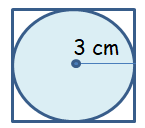
Radius of the circle = 3 cm
Area of the circle = πr2
= π (3)2
= 9π cm2
So, area of the required circle is 9π cm2.
Problem 2 :
The area of the square that can be inscribed in a circle of radius 8 cm is :
(a) 256 cm2 (b) 128 cm2 (c) 64 2 cm2 (d) 64 cm2
Solution :
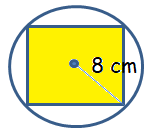
Diameter of the circle = diagonal of the square
Length of diagonal = 16 cm
Let x be the side length of the square
x2 + x2 = 162
2x2 = 256
x2 = 128
x = √(2 x 2 x 2 x 2 x 2 x 2 x 2)
x = 8√2 (side length of the square)
Area of the square = x2 = 128 cm2
Problem 3 :
Area of the largest triangle that can be inscribed in a semi-circle of radius r units is :
a) r2 sq.units b) (1/2) r2 sq.units c) 2r2 sq.units
d) √2 r2 sq.units
Solution :
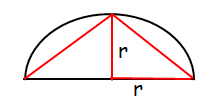
Area of the triangle = (1/2) x base x height
= (1/2) x r x r
= (1/2) r2 square units
Problem 4 :
The circumference of the circle is 100 cm. Find the side of the square inscribed in the circle
Solution :
Circumference of the circle = 100 cm
2π r = 100
r = 100 x (1/2) x (7/22)
r = 15.9
Approximately the radius of the circle is 16 cm
When square inscribed in the circle, there must be a relationship between side length of the square and diameter of the circle. They will be equal.
2(radius) = diameter = 2(16) ==> 32 cm
Problem 5 :
The area of the circle that can be inscribed in a square of the side 6 cm is
Solution :
Here the circle inscribed in a square.
Diameter of the circle = Side length of the square
2r = 6
r = 3
Radius of the circle is 3 cm
Area of the circle = π r2
= π (3)2
= 9π cm2
Problem 6 :
In the figure, a circle is inscribed in a square of side 6 cm and another circle is circumscribing the square. Is it true to say that area of the outer circle is two times the area of the inner circle? Give reasons for your answer
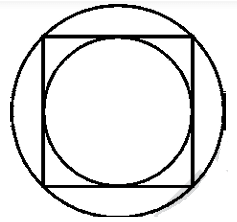
Solution :
The side length of the square is 6 cm
Diameter of the inner circle = 6 cm
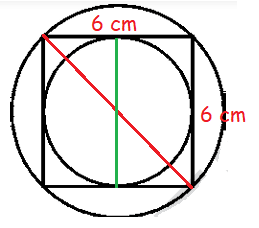
Diameter of the the larger circle that lies outside
62 + 62 = (diagonal of square)2
36 + 36 = (diagonal of square)2
(diagonal of square)2 = 72
(diagonal of square) = √72
Diagonal of the square = 6√2 = Diameter of the larger circle
Diameter of the smaller circle that lies inside = 6
Radius of the circle lies inside = 3 cm
Area of the smaller circle = π r2
= π (3)2
= 9 π square units
Radius of the larger circle = 6√2/2
= 3√2
Area of the larger circle = π r2
= π (3√2)2
= 18 π square units
Area of the outside circle = 2 area of the smaller circle
Problem 7 :
The area of a circle inscribed in an equilateral triangle is 154 cm2. Find the perimeter of the triangle
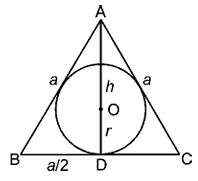
Solution :
Area of the circle = π r2
π r2 = 154
r2 = 154 x (7/22)
r2 = 7 x 7
r = 7
Given ABC is an equilateral triangle and AD = h be the altitude.
Hence these bisectors are also the altitudes and medians whose point of intersection divides the medians in the ratio 2 : 1
∠ADB = 90° and OD = (1/3) AD
That is r = (h/3)
Þ h = 3r = 3 × 7 = 21 cm
Let each side of the triangle be a, then
Altitude of an equilateral triangle is (√3/2) times its side
That is h = (√3a/2)
a = 14√3 cm
Perimeter of the triangle = 3(14√3)
= 42√3 cm
Subscribe to our ▶️ YouTube channel 🔴 for the latest videos, updates, and tips.
Recent Articles
-
Finding Range of Values Inequality Problems
May 21, 24 08:51 PM
Finding Range of Values Inequality Problems -
Solving Two Step Inequality Word Problems
May 21, 24 08:51 AM
Solving Two Step Inequality Word Problems -
Exponential Function Context and Data Modeling
May 20, 24 10:45 PM
Exponential Function Context and Data Modeling